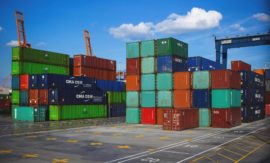Intended learning outcomes: Differentiate between terms such as logistics, operations, logistic management, operations management, and value-added management.
Continuation from previous subsection (1.1.5).
Logistics is involved with products over their entire life cycle:
Logistics is the organization, planning, and realization of the forward and reverse flow and storage of goods, data, and control[note 103] along the entire product life cycle.
Logistics management is the efficient and effective management of logistics activities to meet customers' requirements.
The term “operations management” is very similar to the above definition of logistics management.
Operations, according to [RuTa17], is a function or a system that transforms input to output of greater value.
Operations management, according to [ASCM22], is the planning, scheduling, and control of the activities that transform input into finished goods and services.
Operations Management also denotes concepts from design engineering to industrial engineering, management information systems, quality management, production management, accounting, and other functions as they affect the operation. According to [RuTa17], it denotes the design and operation of productive systems — systems for getting work done.
It also makes sense to view the other functional terms found all along the company’s value chain, namely, procurement, production, and sales, from the management perspective. In the literature, functional terms are usually defined clearly and distinctly. In contrast, for management terms — like procurement management, production management, and sales management — there often are no formal definitions. In practical usage, however, these terms are increasingly similar to the definitions given above for logistics or operations management. This is not surprising, for it is impossible to conduct successful operations management if it is applied to only a part of the value chain. For this reason, we assume in the following that there are no significant differences among all these management terms.
Value-added management can thus be used as a generalized term for all the types of management mentioned above. [note 104].
Figure 1.1.5.2 shows a graphical representation of how the terms fit the company’s world.
Fig. 1.1.5.2 Assignment of terms to value-added management.
This animation shows a graphical representation of how the terms fit the company's internal and external activities
Click on the start button to begin the demonstration.
Course section 1.1: Subsections and their intended learning outcomes

1.1 Basic Definitions, Issues, and Challenges
Intended learning outcomes: Produce an overview on terms of the working environment and of business life. Explain service orientation in the classical industry, product orientation in the service industry, and the industrial product-service system. Disclose the product life cycle, the synchronization of supply and demand, and the role of inventories. Produce an overview on supply chain management, the role of planning and control as well as the SCOR model.

1.1.1 Work, Task, Process, Method, Object, etc. — Important Terms of the Working Environment
Intended learning outcomes: Produce an overview on terms of the working environment, such as work, task, function, order, procedure, process, method, object, business.

1.1.1b Value-Added, Business Process, Material, Product, etc. — Important Terms of Business Life
Intended learning outcomes: Produce an overview on terms of business life, such as value-added, business process, business method, business object, goods, item, part, component, material, product, artifact, management, etc.

1.1.2 Service and Servitization — Service Orientation in the Classical Industry
Intended learning outcomes: Present terms of the service domain such as service, customer service, service in the originary sense, servitization. Differentiate between a (primary, or core) product, a product in a broad sense, and a product in the most comprehensive sense.

1.1.3 The Service Industry and Industrialization of Service — Product Orientation in the Service Industry
Intended learning outcomes: Differentiate between service industry and classical (or conventional) industry. Produce an overview on industrialization of service.

1.1.4 The Industrial Product-Service System IPSS (or IPS2)
Intended learning outcomes: Present the industrial product-service system. Explain product-oriented, use-oriented, and result-oriented services as well as their degree of intangibility.

1.1.5 The Product Life Cycle: Design and Manufacturing, Service and Use, Recycling and Disposal
Intended learning outcomes: Differentiate between terms such as logistics, operations, logistic management, operations management, and value-added management.

1.1.5b Logistics, Operations, Logistics Management, Operations Management, and Value-Added Management
Intended learning outcomes: Differentiate between terms such as logistics, operations, logistic management, operations management, and value-added management.

1.1.6 The Customer Tolerance Time (or Demand Lead Time), and the Role of Inventories
Intended learning outcomes: Describe supply, demand, lead time, and customer tolerance time. Explain the problem of temporal synchronization between supply and demand as well as the role of various kinds of inventories in solving this problem.

1.1.7 Supply Chain, Extended Enterprise, and Supply Chain Management
Intended learning outcomes: Describe the reasons for logistics networks, production networks, procurement networks, distribution networks, and service networks. Produce an overview on the supply chain, the extended enterprise and supply chain management.

1.1.8 Circular Economy and Integral Logistics Management
Intended learning outcomes: Present circular economy and integral logistics management.

1.1.9 Supply Chain Planning and the Planning & Control System
Intended learning outcomes: Produce an overview on supply chain planning. Differentiate between production planning and control (PPC) and a PPC system.
